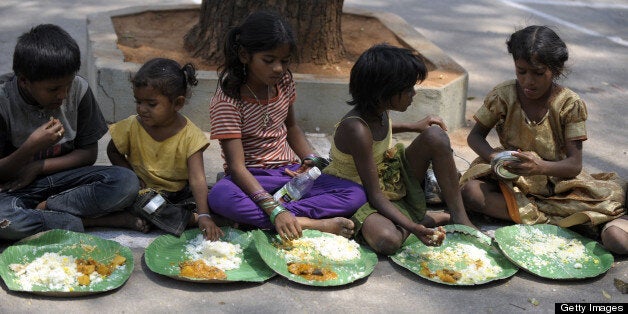

Stella Nordhagen [2009] is a Gates Cambridge Scholar completing a PhD in Land Economy at the University of Cambridge. It has focussed on crop choice, climate change, and agricultural development in Ethiopia and Papua New Guinea; her past expertise is in public health, and she also holds a Cambridge MPhil. in Environmental Policy and Economics. After completing her PhD she will be taking up a fellowship with the US Congressional Hunger Center to work on issues of crop diversity, food security, and nutrition in West Africa in conjunction with the NGO Helen Keller International.
Next week's G8 summit has turned global attention to combatting malnutrition. It is a long-overdue opportunity to reinvigorate agricultural development, funding for which has been largely stagnant for two decades. Yet to succeed, approaches must set aside their yen for technological 'silver bullets' whilst remembering two truths: malnutrition is rarely about not having enough food, and food is not all that agriculture delivers.
Academic scholarship has highlighted that food insecurity is often due not to inadequate food availability, but rather impeded access and utilisation, often poverty-based. Upping production will not decrease hunger if political, social, and financial barriers constrain access for the disenfranchised. The food-price riots of 2007/8 showed how international market dynamics can elevate prices beyond the poor's purchasing power. Even if accessible, food must be the right kind: millions worldwide suffer from the 'hidden hunger' of micronutrient deficiencies. Even with calorie-sufficient diets, limited proteins, fruits, and vegetables leave millions deficient in vitamins and minerals. In addition to direct effects (such as blindness and stunting), these deficiencies increase infectious disease mortality. By impinging on child development, they perpetuate lasting health inequalities across generations - even amidst bountiful staple grain harvests.
Further, the farmer harvesting this grain gains not only food. Smallholder farming is the major income source for many food-insecure households - paying tuition for the next generation to escape poverty, for example. As a livelihood, agriculture imparts great pride: Crops and livestock meet cultural needs, as well as economic ones, providing personal and social meaning. The 'cultural' can thus not be isolated from agricultural decisions. Furthermore, agriculture embodies complex human-and-ecosystem interactions - yields are fundamentally dependent on natural resources, which farmers' actions invariably impact (for both good and ill). The improved seeds, pesticides, and fertilisers that fuelled Asia's 'Green Revolution' have thus far failed to take root in variable, risky African soils and increased agriculture's environmental footprint to about 1/3 of global greenhouse-gas emissions. Production gains must now be reached against a backdrop of water scarcity, soil depletion, and climate change, expected to seriously challenge (though also create opportunities for) agriculture.
These dual truths make 'silver bullets' elusive in agricultural development (versus, e.g., global health, where a single shot can make a life-saving difference). A host of interventions, thinking shifts, and policies will be needed to end food insecurity. Foremost, efforts should focus on smallholders: supplying 80% of the developing world's food, their poverty is the root of most global hunger. Efforts should seek to enhance overall resilience of livelihoods, enabling access to more nutritious food - with the knowledge required to utilise it. One key example is crop diversification: educating and supporting farmers to grow wider ranges of crops and livestock, including local varieties, can diversify diets, improving micronutrient deficiencies. It can increase profits in marketing, potentially opening new markets, though this requires both education and improved supply chains (about 1/3 of global output is lost post-harvest). Diverse farms can be more resilient to environmental stresses, such as pests. Yet polices such as grain/fertiliser subsidies and over-emphasis on cash (export) crops can incentivise monocultures. Such programmes must be rethought.
Multifaceted problems need multi-pronged solutions. Education initiatives (for instance, promoting proper nutrition in a child's crucial first 1,000 days) impart the understanding needed for action. Private-sector partners, particularly multinational buyers of commodities like cocoa, have potential to provide training and certification schemes that can benefit both smallholder suppliers and company bottom-lines by securing sustainable, high-quality production. Technology can help bridge physical infrastructure gaps, for example, using mobiles to disseminate climate forecasts.
Scientifically bred crops, including bio-fortified contributions like 'golden rice', will likely play a role - but those heralding a new Green Revolution should heed lessons of the first, in terms of environmental impact, implications for farmers' rights, and inability to transfer to African contexts. Such efforts should recognise farmers' considerable knowledge and experience managing complex agro-ecological conditions - this has worth that 'new seeds' cannot (and should not) supplant. Successful approaches must leverage both.
Shining the global spotlight on malnutrition, David Cameron is emphasising one of the most crucial areas of development - but also one of the messiest. Improving nutrition through agriculture requires long-term, sustained interest and investment - not just weekend photo ops. Let's hope world leadership can stomach this commitment; in so doing, they can make freedom from hunger a global human right.
